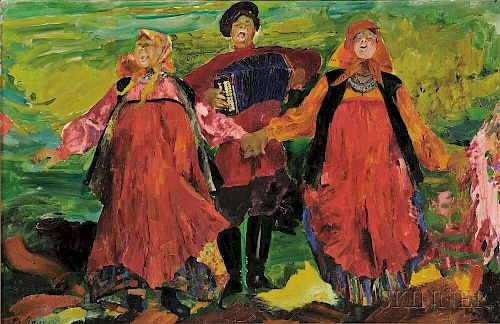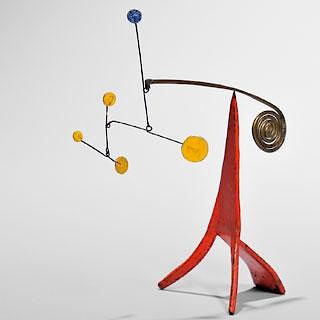Philippe Maliavine (Russian, 1869-1940) Russian Peasants Singing
Lot 404
About Seller
Bonhams Skinner
274 Cedar Hill Street
Marlborough, MA 01752
United States
Founded over four decades ago, Bonhams Skinner offers more than 60 auctions annually. Bonhams Skinner auctions reach an international audience and showcase the unique, rare, and beautiful in dozens of categories, including the fine and decorative arts, jewelry, modern design, musical instruments, sc...Read more
Categories
Estimate:
$150,000 - $250,000
Absentee vs Live bid
Two ways to bid:
- Leave a max absentee bid and the platform will bid on your behalf up to your maximum bid during the live auction.
- Bid live during the auction and your bids will be submitted real-time to the auctioneer.
Bid Increments
| Price | Bid Increment |
|---|---|
| $0 | $10 |
| $100 | $25 |
| $500 | $50 |
| $1,000 | $100 |
| $3,000 | $250 |
| $5,000 | $500 |
| $10,000 | $1,000 |
| $30,000 | $2,500 |
| $50,000 | $5,000 |
| $100,000 | $10,000 |
| $300,000 | $25,000 |
| $500,000 | $50,000 |
| $1,000,000 | $100,000 |
About Auction
By Bonhams Skinner
Jan 27, 2017 - Jan 28, 2017
Set Reminder
2017-01-27 16:00:00
2017-01-28 16:00:00
America/New_York
Bidsquare
Bidsquare : Fine Paintings & Sculpture
https://www.bidsquare.com/auctions/skinner/fine-paintings-sculpture-2062
Bonhams Skinner bidsquare@bonhamsskinner.com
Bonhams Skinner bidsquare@bonhamsskinner.com
- Lot Description
Philippe Maliavine (Russian, 1869-1940)
Russian Peasants Singing
Signed "Ph.Maliavine." l.l., identified on a presentation plaque, dated "1899" on a gummed label on the stretcher, titled on an exhibition label affixed to the stretcher.
Oil on canvas, 23 3/4 x 36 1/8 in. (60.5 x 91.5 cm), framed.
Condition: Lined, drying cracks.
Provenance: Sotheby's New York, Russian Art, April 23, 2004, Lot 20, to a private Rhode Island collection.
Exhibitions: Petit Palais-Gèneve, Post-Impressionisme (1880-1910), July 1 - September 30, 1980.
N.B. Philippe Maliavine (Filipp Malyavin) was one of the leading Russian painters of the early 20th century. Born into a large and very poor peasant family in the village of Kazanka, Maliavine developed an early love of art from the exposure to icons brought to the village by travelling monks. He convinced his family to send him to Mount Athos to study icon painting, and with the help of the village, at age 16 he made the journey to Greece. He was disappointed when he arrived to learn that the monks there were actually copying Russian icons, but since he lacked the money to return home, he became a novice assigned to paint icons and murals. Through the generosity of the artist Vladimir Beklemishev, who visited the monastery and recognized the talent of the young artist, Maliavine returned to Russia in 1892 to study at the St. Petersburg Academy of Arts, entering the studio of Ilya Repin. There Maliavine developed his skills as a gifted portrait painter and also began his paintings of Russian peasants, a theme which while initially controversial would become his lasting legacy. Laughter (1899), his bold painting of peasant women in flowing red dresses in a green meadow, created as his graduation work for the Academy of Arts, was actually rejected by the Academy, but subsequently earned Maliavine the Gold Medal at the World Exhibition in Paris (1900). The more conservative Academy awarded Maliavine the title of "Artist" based on the quality of his work in portraiture, while his peasant canvases found favor abroad and were purchased by museums in Paris and Venice.
From 1901 through 1910 Maliavine lived in Ryazan province, where he developed his paintings of large scale peasant figures, who appeared as strong-willed and independent individuals. In these compositions, sometimes of single figures, other times showing two or three together, the figures are brought to the foreground and are presented from a low angle to increase their monumentality. These peasants are not always beautiful, but they radiate inner strength and integrity, and they reveal age, character, and mood.
Maliavine's style developed as a fusion of Russian Impressionism and traditional folk themes with abstraction, influenced by French painting and by the Swedish artist Anders Zorn. His works are noted for his expressive brushwork, sweeping movement, and love of strong color, especially reds. However, by 1910 Maliavine was falling out of favor with the official art critics. He was not banned, but was considered "decadent" by the influential critic Vladimir Stasov, for whom the lively, healthy, and colorful peasants of Maliavine did not coincide with the political image of the oppressed people of the countryside. By the 1920s the Russian hierarchy would only permit the exhibition of paintings deemed to have "educational value," and the country's rich holdings of Impressionist, Post-Impressionist, and Fauve works were removed from view. Maliavine immigrated to Paris in 1922, and lived there and in Nice through the 1930s. During World War II he fled to Brussels, where he was arrested by the Gestapo in 1940 and accused of espionage. He was subsequently released and is said to have walked all the way back to Nice, where he died the next year.
Maliavine's name takes various forms as translated into French and English, and variations may be spelled Phillipe Maliavine, Filip, Filipp, or Philip Malyavin, Maljavin, or Maljawin.
Estimate $150,000-250,000
The absence of a condition statement does not imply that the lot is in perfect condition or completely free from wear and tear, imperfections or the effects of aging. Condition requests can be obtained via email (lot inquiry button) or by telephone to the appropriate gallery location (Boston/617.350.5400 or Marlborough/508.970.3000). Any condition statement given, as a courtesy to a client, is only an opinion and should not be treated as a statement of fact. Skinner Inc. shall have no responsibility for any error or omission. - Shipping Info
-
Please visit http://www.skinnerinc.com/services/payment-and-shipping/ for information regarding the collection of items purchased at auction.
-
- Buyer's Premium



 EUR
EUR CAD
CAD AUD
AUD GBP
GBP MXN
MXN HKD
HKD CNY
CNY MYR
MYR SEK
SEK SGD
SGD CHF
CHF THB
THB











